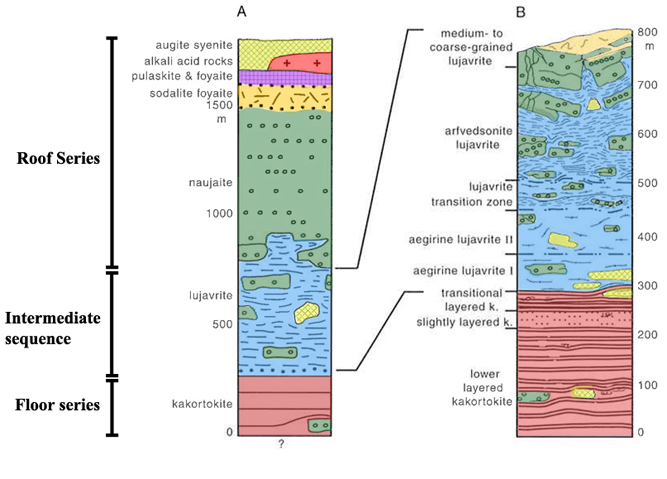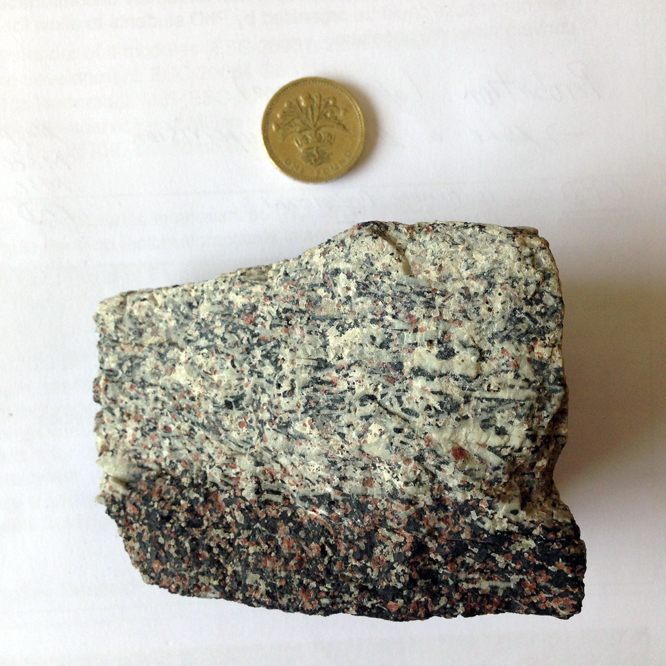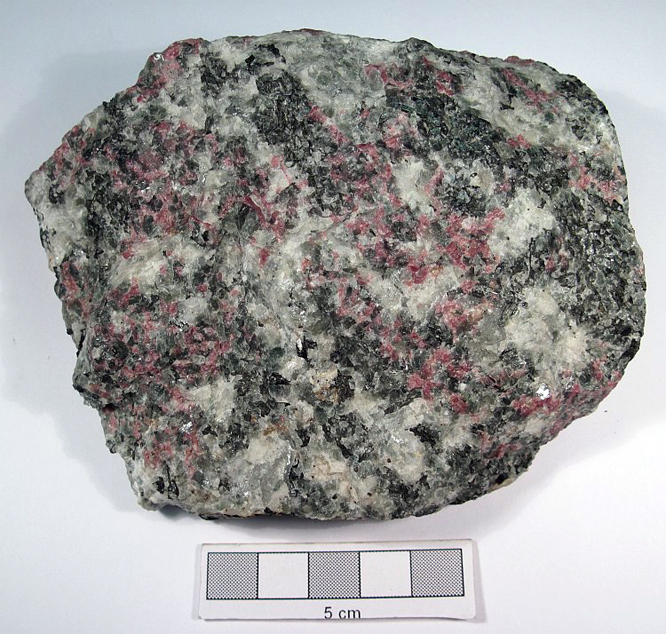Ilimaussaq intrusive complex
The Ilímaussaq complex (Fig.1) is one of several alkaline complexes formed during Mesoproterozoic rifting in the southwestern part of Greenland, which collectively is called the Gardar province. With an age of 1.6 Ga, Ilímaussaq is the youngest major intrusion of the Gardar province. The Ilímaussaq alkaline complex is among the largest known alkaline complexes in the world and has been studied since the early 19th century. Ilímaussaq is the type locality for 34 minerals, including 15 that have not been reported elsewhere. Some of these are rock-forming minerals and thus, although unique to Ilímaussaq, may not be considered rare.2017(1).jpg)
Fig.1: Simplified geological map of the Ilímaussaq complex. Modified from Hunt (2017).
The first detailed mapping and petrological studies of the complex were published by Ussing (1912), who also defined the term "agpaitic" for rocks where the molar ratio (Na+K)/Al is greater than or equal to 1.2. Since then, the distinction between agpaitic and miaskitic has changed from being based on just rock chemistry to being based more on mineral paragenesis. Sørensen (1997) defined agpaitic as peralkaline rocks in which High Field Strength Elements (e.g., Zr and Ti) are hosted in complex minerals such as eudialyte and rinkite. Rocks with high alkalinity, where HFSE are hosted in minerals such as zircon, are considered miaskitic. Khomyakov (1995) further developed the agpaitic classification by introducing the term hyperagpaitic for the most evolved syenites. Hyperagpaitic rocks are characterised by containing water soluble minerals (e.g., natrosilite and natrophosphate) and complex phosphosilicates (e.g., steenstrupine-(Ce) and vuonnemite).
The complex measures 17 × 8 km, and the exposed vertical thickness is about 1700 m. It is estimated that the complex was emplaced 3-4 km below the contemporary surface at the discontinuity between the Ketilidian crystalline basement (c.1800 Ma) and the overlying Eriksfjord Formation made up of continental sandstones and lavas of mainly basaltic composition.The basement and the overlying sandstones and lavas are intruded by numerous mainly basaltic dykes. The Eriksfjord Formation is the surface expression of Gardar activity and is preserved only in down-faulted blocks. Gardar activities embrace the period 1350 to c. 1120 Ma; the Ilímaussaq complex (dated at 1143 +/- 21 Ma) is thus an expression of young Gardar activity.The basalts in the part of the Gardar rift zone which contains the Ilímaussaq igneous complexes (Fig.1) are richer in alkalis, P, Ba, Sr, Nb and LREE than the basic rocks in other parts of the Gardar province. This indicates an origin in a mantle source enriched in incompatible elements, perhaps because of metasomatism. The agpaitic nepheline syenites of the Ilímaussaq complex are considered to be products of extended fractionation of transitional to alkali basaltic melts in deep magma chambers combined with some crustal contamination.
Ilimaussaq magmatic phases
According to Larsen & Sørensen (1987), the Ilímaussaq igneous complex was formed by successive intrusion of three melts batches at 3-4 Km depth (Fig.2-3-4):Stage I: The first phase is made up of augite syenite. It occurs both as thin shell with a thickness of few hundred meters along the wester, southern and southeastern margins of the intrusion and as a lid (150 m) on the top of the intrusion.
Stage II: The second phase consists of alkali granite and quartz syenite which are found in the roof and as blocks engulfed by rocks of the third intrusive phase.
Stage III: The third intrusive phase occupies the major part of the complex. It is made up of a roof series, a floor series, and an intermediate sequence. During this stage, nepheline- and sodalite-bearing syenites formed. Minor volumes of pulaskite, foyaite and the so called “sodalite foyaite” are interpreted to have crystallized in situ from the roof downwards, whereas the naujaite represents a flotation cumulate of sodalite.
.jpg)
Fig.2: Successive intrusion of three melt batches at Ilimaussaq
.jpg)
Fig.3: E-W Schematic section of the Ilímaussaq alkaline complex. From Jens Konnerup-Madse.

Fig.4: Schematic section through the c. 1700 m of exposed stratigraphy of the Ilímaussaq alkaline complex.
The Roof Series:
The roof series (Fig.4) crystallised from the top downwards, forming the succession pulaskite, foyaite, sodalite foyaite and naujaite. The contacts of these rocks grade into each other, but blocks of the uppermost rocks were loosened from the temporary roof of the magma chamber and engulfed by the underlying crystallising rocks. Larsen (1976) demonstrated that there is a gradual evolution in mineralogy from pulaskite to naujaite. The primary mineral association alkali feldspar, nepheline, fayalite, hedenbergite, apatite and titanomagnetite is substituted downwards by sodalite, nepheline, alkali feldspar, aegirine, arfvedsonite, eudialyte and aenigmatite.
The floor series:
The floor series (Fig.4) is made up of a layered and laminated series of kakortokite, that is an agpaitic nepheline syenite with the major minerals alkali feldspar, nepheline, aegirine, arfvedsonite and eudialyte. The bottom of the series is unknown. The lowermost visible part is made up of centimetre-thick layers with varying contents of mafic minerals, feldspar and eudialyte.
The layered series of kakortokite passes gradually upwards into a thin unit of transitional layered kakortokite which again passes gradually into the intermediate sequence of lujavrites.
Intermediate sequence:
The upper part of the intermediate sequence (Fig.4) is made up of black arfvedsonite- rich, fine-grained laminated rocks. Dykes and sheets of lujavrite intersect the rocks of the roof zone. On the Kvanefjeld plateau, in the northernmost part of the complex, lujavrites are in contact with the volcanic roof of the complex, which is strongly fenitised adjacent to the lujavrites. Bohse & Andersen (1981) distinguish a lower aegirine lujavrite I zone which gradually passes into the overlying aegirine lujavrite II, a transitional lujavrite zone and a arfvedsonite lujavrite zone.
There are several generations oflujavrite. For exemple, one of the latest phases consists of naujakasite lujavrite rich in steenstrupine (instead of eudialyte), this represents the hyper-agpaitic stage of development characterised by naujakasite, steenstrupine, ussingite, vitusite and other minerals.
Petrography of Ilímaussaq alkaline rocks
Augite syenitesThe augite syenite shows a xenomorphic texture with grain size varying between 2 and 20 mm. The main minerals are: strongly exsolved perthitic alkali feldspar, olivine, clinopyroxene and Fe–Ti oxides. Sodalite foyaites
This rock type is typically medium to coarse grained with grain sizes up to 20 mm. The main minerals are: euhedral perthitic alkali feldpar, nepheline, sodalite, olivine and resorbed relics of augite, sector-zoned Na-rich clinopyroxene, aenigmatite, fluorite, rare eudialyte and zoned ferrorichterite. Analcime appears to occur as a late liquidus phase, but most analcime forms together with secondary sodalite by subsolidus replacement of primary sodalite and nepheline.
Kakortokites
Kakortokite is a medium- to coarse-grained nepheline syenite and forms the main magmatic layered part of the intrusion in the southern part of the complex (Fig.1). Most of the 29 described units consist of three layers, which are named based on colour. Basal black layers of predominantly arfvedsonite are followed by red layers rich in eudialyte, then by white layers rich in nepheline and alkali-feldspar, which are generally the thickest. The layers maintain a consistent thickness throughout a unit. Although most of the units contain all three layers, some do not. Black layers have abrupt lower contacts with subjacent white layers, but typically pass gradationally upwards to red layers. The units are labelled based on their position with respect to a marker unit called zero (e.g., unit +16 is the 16th unit above the marker; unit -3 is the 3rd unit below the marker).

Fig.5: Schematic representation of the magmatic layering in kakortokite. Image modified from Hunt, et al., (2017).
Naujaites
Naujaite is a cumulate rock consisting of large (up to 5 mm) euhedral sodalite crystals that floated to the top of the magma chamber. Later crystallising phases are mainly nepheline, alkali-feldspar, aegirine, arfvedsonite, and eudialyte, which result in a predominantly poikilitic texture. Individual feldspars can be up to 25 cm, and both aegirine and arfvedsonite can form crystals up to 30 cm. The amount of eudialyte in naujaite is inconsistent and it may be completely absent. Rinkite is a common accessory mineral in naujaite, which is the most exposed rock in Ilímaussaq.
Lujavrites
Lujavrite is a meso- to melanocratic agpaitic to hyperagpaitic syenite with a pronounced lamination caused by the orientation of mafic minerals and, in part, felsic minerals such as feldspars. The two most abundant varieties of lujavrite in Ilímaussaq are named based on colour: in green lujavrite the predominant mafic mineral is aegirine; in black lujavrite, the main mafic mineral is arfvedsonite. The felsic minerals in lujavrite are nepheline, albite, microcline, and sodalite. Lujavrites are fine grained (up to 0.6 mm), but sodalite grains can be up to 2 mm and mafic minerals up to 1 mm. A coarser type of lujavrite is called M-C-lujavrite (M-C stands for medium to coarse grained), in which the individual grains can reach sizes of more than one cm, and are locally pegmatitic. A fourth type, naujakasite lujavrite, contains naujakasite and is associated with the highly agpaitic stage of the complex. In these lujavrites, naujakasite generally occurs at the expense of nepheline. Locally the lujavrite contains up to 75 % volume naujakasite. The water-soluble mineral villiaumite is abundant in most of the lujavrites but has been leached out in some near-surface rocks. Lujavrite is the rock unit containing the highest amounts of incompatible elements and is the major ore of the Kvanefjeld deposit.
.jpg)
Fig.6: Layered kakortokites. Image from HiTech AlkCarb.
1.jpg)
Fig.7: The layered kakortokites from north slopes of Kangerdluarssuk.
.jpg)
Fig.8: Xenoliths of augite syenite within lujavrite. Note the flow banding in the lujavrite and the metasomatic alteration of the augite syenite. Lens cap 45 mm diameter.
.jpg)
Fig.9: Sharp boundary between black (amphibole-rich) and white (feldspar/nepheline- rich) kakortokite. Kringlerne, Ilímaussaq. Image from HiTech AlkCarb.

Fig.10: Sharp boundary between black (amphibole-rich) and white (feldspar/nepheline- rich) kakortokite. Kringlerne, Ilímaussaq. Image from HiTech AlkCarb.
.jpg)
Fig.11: Tugtupite-albite vein surface against host augite syenite.n Chisel is 15 mm wide at top.
.jpg)
Fig.12: Aegirine-eudialyte syenite pegmatite in naujaite. From Hunterian Museum Geology Collections
.jpg)
Fig.13: Polished surface of typical naujaite. Note pink eudialites poililitically enclose alkali feldspar on a large scale and sodalite on a small scale.

Fig.14: Naujaite sample. Sodalite (gray), microcline (white), arfvedsonite (black), eudialyte (red). From Hunterian Museum Geology Collections
.jpg)
Fig.15: Kakortokite sample. microcline (white) and eudialyte (red).
.jpg)
Fig.16: Analcime-rich lujavrite. From Hunterian Museum Geology Collections
.jpg)
Fig.17: Steenstrupine (dark, big crystals) in a lujavrite. From Friends of Minerals Forum.
.jpg)
Fig.18: Naujakasite-rich lujavrite. Arfvedsonite (black), villiaumite (red) and naujakasite (lozenge-shaped).
Bibliography
• Hunt, E. J., Finch, A. A., & Donaldson, C. H. (2017). Layering in peralkaline magmas, Ilímaussaq Complex, S Greenland. Lithos, 268, 1-15.
• Andersen, T., & Friis, H. (2015). The transition from agpaitic to hyperagpaitic magmatic crystallization in the Ilímaussaq alkaline complex, South Greenland. Journal of Petrology, 56(7), 1343-1364.
• Friis, H. (2015). Primary and secondary mineralogy of the Ilímaussaq alkaline complex, South Greenland. In Symposium on critical and strategic materials. British Columbia Geological Survey Paper (Vol. 3, p. 83).
• Markl, G., Marks, M., Schwinn, G., & Sommer, H. (2001). Phase equilibrium constraints on intensive crystallization parameters of the Ilímaussaq Complex, South Greenland. Journal of Petrology, 42(12), 2231-2257.
• Sørensen, H. (Ed.). (2001). The Ilímaussaq alkaline complex, South Greenland: status of mineralogical research with new results.
• Sørensen, H. (1997). The agpaitic rocks-an overview. Mineralogical Magazine, 61(4), 485-498.
• Khomyakov, A.P., 1995. Mineralogy of Hyperagpaitic Alkaline Rocks. Oxford University Press, Oxford, 223p.
• Larsen, L. M., & Sørensen, H. (1987). The Ilímaussaq intrusion—progressive crystallization and formation of layering in an agpaitic magma. Geological Society, London, Special Publications, 30(1), 473-488.

